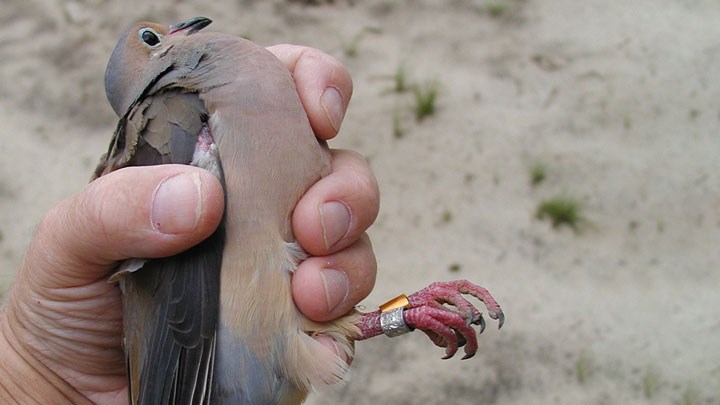
by Michael D. Faw - Thursday, November 5, 2020

When you bag a duck, dove or other game bird while hunting, always take a close look at the bird’s legs for a band, or as some hunters like to call it: jewelry. The National Bird Banding Laboratory operated by the U.S. Geological Survey (USGS), a fact-finding research organization, would like to hear from you if you down a bird wearing a leg or neck band.
Numerous federal agencies, state game departments and specially licensed individuals and groups doing approved scientific research, management and conservation projects trap and band birds across North America. While most hunters know about the small aluminum leg bands that are often found on waterfowl, for example, there also can be colored plastic leg bands, neck collars and wing panels attached to the bird. Those attachments have numbers that are recorded when the bird is captured, providing important tracking details on when and where the bird was banded and where it travelled. A valuable conservation tool, the information collected also provides information on the bird’s habits and needs. In addition, the bands help those who study birds to learn more about their interesting lives and the number of years they live while providing information on their wintering and summer nesting grounds.
You can submit bird band info (a series of numbers and letters) to the USGS Laboratory using its free downloadable Bandit software, the latest desktop application designed to help bird banders manage and submit their data on banded birds or by visiting http://www.reportband.gov. Approximately a million bands are distributed to banding centers and sites each year, and approximately 100,000 bands are reported each year—including those by hunters.
To apply the bands, most migratory birds are trapped using nearly invisible, mesh mist nets, sometimes with the use of cannon-fired large nets, or they are captured while flightless and on the nest. Look closely at a bird in hand as “reward bands” are attached to multiple birds each year. If your bird has one of these bands, you could receive a certificate of appreciation and detailed information about the bird.
If you find a band on a bird and have difficulty reading the numbers because they are partially worn off, you can submit the band to the USGS Laboratory (and it will be returned) via U.S. mail. Write "HAND CANCEL" on the envelope and send it to this address: Patuxent Bird Banding Laboratory, Attention: Band to Be Etched, 12100 Beech Forest Lane, Laurel, MD 20708. Additional details on bird bands can be found at http://www.usgs.gov.
Editor’s Fast Fact: The information collected through bird banding—where a bird was banded, where it was recovered and how long it lived—was used to develop America’s flyway system, which biologists have used to manage migratory birds since 1950. Seventy years later, the U.S. Fish and Wildlife Service and its partners manage migratory birds based largely on the travel routes birds use when migrating between their nesting and wintering areas. Today North America’s four administrative flyways (Atlantic, Mississippi, Central and Pacific) continue to aid in the management of migratory birds and their habitats.
About the Author
Avid sportsman Michael D. Faw is the owner of Faw's Marketing and Communications Services near Great Falls, Mont. He and his Weimaraner, Cameron, spend countless hours afield, including to work on wildlife conservation and habitat enhancement projects. Most recently, Faw said Cameron helped him to bury 600 feet of water line to create a pool for thirsty pronghorns below their home.
E-mail your comments/questions about this site to:
[email protected]
